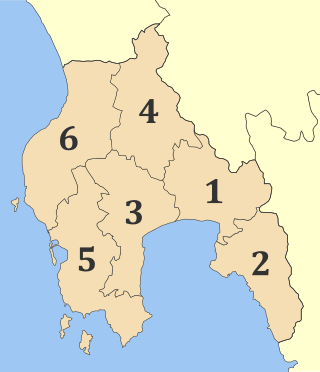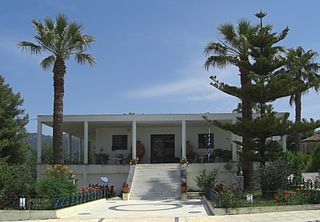Related Research Articles

Pylos, historically also known as Navarino, is a town and a former municipality in Messenia, Peloponnese, Greece. Since the 2011 local government reform, it has been part of the municipality Pylos-Nestoras, of which it is the seat and a municipal unit. It was the capital of the former Pylia Province. It is the main harbour on the Bay of Navarino. Nearby villages include Gialova, Pyla, Elaiofyto, Schinolakka, and Palaionero. The town of Pylos has 2,345 inhabitants, the municipal unit of Pylos 5,287 (2011). The municipal unit has an area of 143.911 km2.
Neleus was a mythological king of Pylos. In some accounts, he was also counted as an Argonaut instead of his son, Nestor.

Messene, officially Ancient Messene, is a local community within the regional unit of Messenia in the region (perifereia) of Peloponnese.

Messenia or Messinia is a regional unit in the southwestern part of the Peloponnese region, in Greece. Until the implementation of the Kallikratis plan on 1 January 2011, Messenia was a prefecture (nomos) covering the same territory. The capital and largest city of Messenia is Kalamata.

In Greek mythology Nestor of Gerenia was a legendary king of Pylos. He is a prominent secondary character in Homer's Iliad and Odyssey, where he appears as an elderly warrior who frequently offers long-winded advice to the other characters.

Carl William Blegen was an American archaeologist who worked at the site of Pylos in Greece and Troy in modern-day Turkey. He directed the University of Cincinnati excavations of the mound of Hisarlik, the site of Troy, from 1932 to 1938.

The American School of Classical Studies at Athens (ASCSA) is one of 19 foreign archaeological institutes in Athens, Greece. It is a member of the Council of American Overseas Research Centers (CAORC). CAORC is a private not-for-profit federation of independent overseas research centers that promote advanced research, particularly in the humanities and social sciences, with focus on the conservation and recording of cultural heritage and the understanding and interpretation of modern societies.

Nichoria is a site in Messenia, on a ridgetop near modern Rizomylos, at the northwestern corner of the Messenian Gulf. From the Middle to Late Bronze Age it cultivated olive and terebinth for export. During the Helladic period it was part of the Mycenaean civilisation.
William Andrew "Bill" McDonald was a Canadian archaeologist.

Jack L. Davis is Carl W. Blegen Professor of Greek Archaeology at the University of Cincinnati in Ohio and is a former Director of the American School of Classical Studies at Athens.

The Palace of Nestor was an important centre in Mycenaean times, and described in Homer's Odyssey and Iliad as Nestor's kingdom of "sandy Pylos".

Pacbitun is a Maya archaeological site located near the town of San Ignacio, Belize, in the Cayo District of west central Belize. The modern Maya name given to the site means “stone set in earth”, likely a reference to multiple fragments of stone monuments. The site, at about 240 m above sea level, is one of the earliest known from the southern Maya Lowlands, and was inhabited for almost 2000 years, from ca. 900 BCE to 900 CE. Strategically, it straddles a territory of rolling, hilly terrain between the Mountain Pine Ridge and the tropical forest covered lowlands of the Upper Belize River Valley.

The Archaeological Museum of Chora is a museum in Chora, Messenia, in southern Greece, whose collections focus on the Mycenaean civilization, particularly from the excavations at the Palace of Nestor and other regions of Messenia. The museum was founded in 1969 by the Greek Archaeological Service under the auspices of the Ephorate of Antiquities of Olympia. At the time, the latter included in its jurisdiction the larger part of Messenia.

Chora is a small town in the western part of Messinia, in the Peloponnese region of southern Greece. With a population of 3.454 inhabitants, it is the largest settlement in the municipality of Pylos-Nestoros and the fifth largest settlement in Messinia. Chora is renowned for its long history. It houses an archeological museum and it is located 3 kilometers away from the Palace of Nestor.

Elizabeth Denny Pierce Blegen was an American archaeologist, educator and writer. She excavated at sites in Greece and Cyprus, contributed reports on archaeological discoveries in Greece to the American Journal of Archaeology from 1925 to 1952, and was involved in several organisations promoting women's professional advancement in Greece and the United States.

Marion Rawson was an American archaeologist. She is known for her work with Carl Blegen at Pylos in Greece and ancient Troy in modern Turkey. After her death, the University of Cincinnati established the Marion Rawson Professorship of Aegean Prehistory "in honor of her contributions to the field of Bronze Age Archaeology."
Sharon (Shari) Stocker is an American archaeologist who is best known, along with her husband, archaeologist Jack L. Davis, for leading an international team of researchers who discovered a previously undisturbed tomb of a Bronze Age warrior in southwest Greece. The 3500 year old intact grave was named the Griffin Warrior Tomb by the research team during the initial excavation in May 2015.
The Griffin Warrior Tomb is a Bronze Age shaft tomb dating to around 1450 BC, near the ancient city of Pylos in Greece. The grave was discovered by a research team sponsored by the University of Cincinnati and led by husband-and-wife archaeologists Jack L. Davis and Sharon Stocker. The tomb site was excavated from May to October 2015.

Richard "Dick" Hope Simpson (1930–2016) was a British Classical archaeologist, known for his work in archaeological survey and the study of Mycenaean Greece. For most of his career, he taught at Queen's University at Kingston in Kingston, Ontario.

The University of Minnesota Messenia Expedition (UMME) was an archaeological expedition in Messenia, Greece conducted between 1953 and 1975. It was devised and begun by William McDonald, who also served as its director for most of its duration.
References
- ↑
- The Pylos Regional Archaeological Project Internet Edition. Retrieved on September 2, 2008. "The Pylos Regional Archaeological Project (PRAP) is a multi-disciplinary, diachronic archaeological expedition formally organized in 1990 to investigate the history of prehistoric and historic settlement and land use in western Messenia in Greece, in an area centered on the Bronze Age administrative center known as the Palace of Nestor. The project has employed the techniques of archaeological surface survey, along with natural environmental investigations (geological, geomorphological, geophysical, and paleobotanical). In the summers of 1991-95, approximately 40 square kilometers in western Messenia were examined intensively. These included areas to the north, east, south, and west of the modern town of Hora, and the entirety of the Englianos Ridge (Upper and Lower) - the location of the Palace of Nestor. Fieldwork doubled the number of sites previously known in the area intensively surveyed. In addition, nearly all previously known sites in an additional 30 square kilometers have been reinvestigated; the spatial extent and chronological components of these have been defined with greater precision. Members of PRAP are committed to making the results of the project quickly available to the general public and scholars through the Internet. The table of contents contains links to existing publications and reports, some of which are available on-line. In addition we are making available a complete site gazetteer, with descriptions of all sites investigated by PRAP and preliminary catalogues of artifacts found at them. We encourage use of this gazetteer for scholarly purposes. The complete pottery catalog, small finds database, and photography database are also searchable on-line.